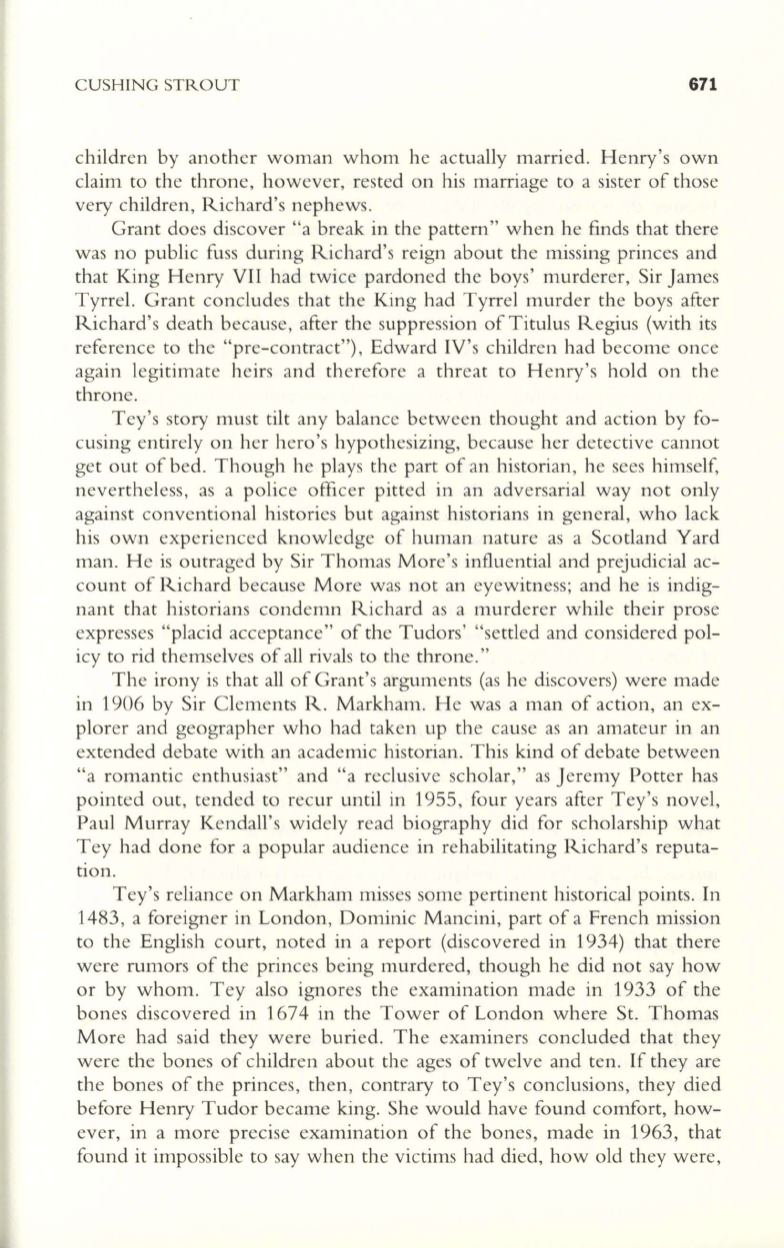
CUSHING STROUT
671
children by another woman whom he actually married. Henry's own
claim to the throne, however, rested on his marriage to a sister of those
very children, Richard's nephews.
Grant does discover "a break in the pattern" when he finds that there
was no public fuss during Richard's reign about the missing princes and
that King Henry VII had twice pardoned the boys' murderer, Sir James
Tyrrel. Grant concludes that the King had Tyrrel murder the boys after
Richard's death because, after the suppression of Titulus Regius (with its
reference to the "pre-contract"), Edward IV's children had become once
again legitimate heirs and therefore a threat to Henry's hold on the
throne.
Tey's story must tilt any balance between thought and action by fo–
cusing entirely on her hero's hypothesizing, because her detective cannot
get out of bed. Though he plays the part of an historian, he sees himself,
nevertheless, as a police officer pitted in an adversarial way not only
against conventional histories but against historians in general, who lack
his own experienced knowledge of human nature as a Scotland Yard
man. He is outraged by Sir Thomas More's influential and prejudicial ac–
count of Richard because More was not an eyewitness; and he is indig–
nant that historians condemn Richard as a murderer while their prose
expresses "placid acceptance" of the Tudors' "settled and considered pol–
icy to rid themselves of all rivals to the throne."
The irony is that all of Grant's arguments (as he discovers) were made
in 1906 by Sir Clements R. Markham. He was a man of action, an ex–
plorer and geographer who had taken up the cause as an amateur in an
extended debate with an academic historian. This kind of debate between
"a romantic enthusiast" and "a reclusive scholar," as Jeremy Potter has
pointed out, tended to recur until in 1955, four years after Tey's novel,
Paul Murray Kendall's widely read biography did for scholarship what
Tey had done for a popular audience in rehabilitating Richard's reputa–
tion.
Tey's reliance on Markham misses some pertinent historical points. In
1483, a foreigner in London, Dominic Mancini, part of a French mission
to the English court, noted in a report (discovered in 1934) that there
were rumors of the princes being murdered, though he did not say how
or by whom. Tey also ignores the examination made in 1933 of the
bones discovered in 1674 in the Tower of London where St. Thomas
More had said they were buried. The examiners concluded that they
were the bones of children about the ages of twelve and ten. If they are
the bones of the princes, then, contrary to Tey's conclusions, they died
before Henry Tudor became king. She would have found comfort, how–
ever, in a more precise examination of the bones, made in 1963, that
found it impossible to say when the victims had died, how old they were,


